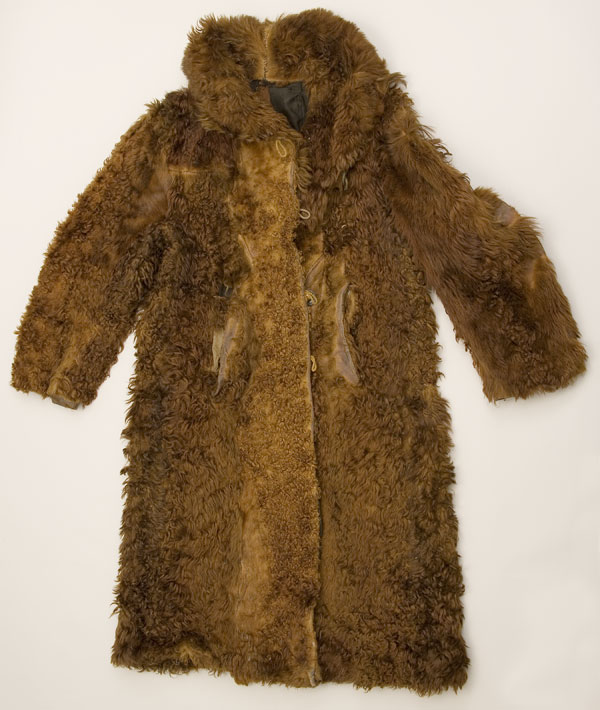Buffalo coat on:
[Wikipedia]
[Google]
[Amazon]
 A buffalo coat is a heavy winter garment made from the
A buffalo coat is a heavy winter garment made from the
File:Buffalo soldiers1.jpg,
 A buffalo coat is a heavy winter garment made from the
A buffalo coat is a heavy winter garment made from the bison
Bison are large bovines in the genus ''Bison'' (Greek: "wild ox" (bison)) within the tribe Bovini. Two extant and numerous extinct species are recognised.
Of the two surviving species, the American bison, ''B. bison'', found only in North Ame ...
, which also commonly known as the "buffalo" (though not closely related to African or Asian buffaloes). In North America they descended from the simpler, sleeveless buffalo robes worn by the Indigenous peoples of North America
The Indigenous peoples of the Americas are the inhabitants of the Americas before the arrival of the European settlers in the 15th century, and the ethnic groups who now identify themselves with those peoples.
Many Indigenous peoples of the Am ...
prior to their partial replacement by capotes made of point blanket
A Hudson's Bay point blanket is a type of wool blanket traded by the Hudson's Bay Company (HBC) in British North America, now Canada and the United States from 1779 to present. The blankets were typically traded to First Nations in exchange for ...
s during the North American fur trade
The North American fur trade is the commercial trade in furs in North America. Various Indigenous peoples of the Americas traded furs with other tribes during the pre-Columbian era. Europeans started their participation in the North American fur ...
. Similar garments were also used across Eurasia prior to the gradual displacement and near-extinction of the European bison or wisent. Commercially produced coats with sleeves and buttons became popular with non-indigenous people during the early settlement period of the American West
The Western United States (also called the American West, the Far West, and the West) is the region comprising the westernmost states of the United States. As American settlement in the U.S. expanded westward, the meaning of the term ''the Wes ...
and the Canadian prairies
The Canadian Prairies (usually referred to as simply the Prairies in Canada) is a region in Western Canada. It includes the Canadian portion of the Great Plains and the Prairie Provinces, namely Alberta, Saskatchewan, and Manitoba. These provin ...
. Their use mostly ended because of a rising conservationist movement
The conservation movement, also known as nature conservation, is a political, environmental, and social movement that seeks to manage and protect natural resources, including animal, fungus, and plant species as well as their habitat for the f ...
intended to preserve the bison, which had been hunted to near-extinction in North America as well.
Buffalo coats were issued to police and military officers, particularly the Royal Canadian Mounted Police
The Royal Canadian Mounted Police (RCMP; french: Gendarmerie royale du Canada; french: GRC, label=none), commonly known in English as the Mounties (and colloquially in French as ) is the federal police, federal and national police service of ...
and the United States Army
The United States Army (USA) is the land service branch of the United States Armed Forces. It is one of the eight U.S. uniformed services, and is designated as the Army of the United States in the U.S. Constitution.Article II, section 2, cla ...
, prior to their replacement by parka
A parka or anorak is a type of coat with a hood, often lined with fur or faux fur. This kind of garment is a staple of Inuit clothing, traditionally made from caribou or seal skin, for hunting and kayaking in the frigid Arctic. Some Inuit ano ...
s. The coats were intended for use in extreme cold or arctic conditions. The RCMP (and other Canadian police services) briefly revived them in the 1930s when 700 hides were donated by the Canadian parks service. Guards on Parliament Hill continued to wear them until 1961. With the growing numbers of farmed bison being raised since the 1990s, buffalo coats are once again available, though they are much more expensive and many times heavier than modern winter wear made of manmade fabrics.
Canadian political commentator Tom Flanagan wears one daily during the winter at the University of Calgary where he teaches, and in 2013 wore it during a panel discussion on the CBC, which drew media attention.
Gallery
Buffalo soldier
Buffalo Soldiers originally were members of the 10th Cavalry Regiment of the United States Army, formed on September 21, 1866, at Fort Leavenworth, Kansas. This nickname was given to the Black Cavalry by Native American tribes who fought in th ...
s some wearing buffalo coats, Ft. Keogh, Montana 1890
File:Dog Child, a North West Mounted Police scout, and his wife, The Only Handsome Woman, members of the Blackfoot Nation, Gleichen, Alberta, ca. 1890.jpg, North-West Mounted Police
The North-West Mounted Police (NWMP) was a Canadian para-military police force, established in 1873, to maintain order in the new Canadian North-West Territories (NWT) following the 1870 transfer of Rupert’s Land and North-Western Territory ...
scout wearing a buffalo coat. Gleichen, Alberta, ca. 1890
File:Bison jacket front.jpg, modern buffalo coat front (2008)
File:Bison jacket back.jpg, modern buffalo coat back (2008)
References
External links
United States Army uniforms Royal Canadian Mounted Police Canadian fashion Western wear Bison Hides (skin) North-West Mounted Police {{clothing-stub